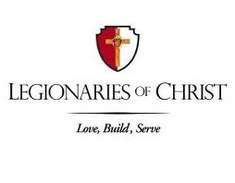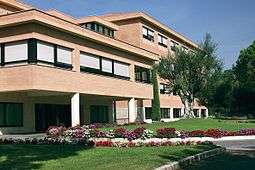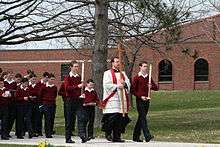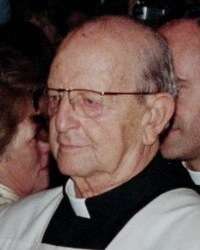Legion of Christ
 | |
| Abbreviation | LC |
|---|---|
| Motto | Adveniat Regnum Tuum |
| Founded | January 3, 1941 |
| Type | Catholic religious institute |
| Headquarters | General Directorate, Via Aurelia 677 |
| Location |
|
General Director | Eduardo Robles Gil |
Key people |
Marcial Maciel - Founder Álvaro Corcuera - Previous General Director Velasio de Paolis - Papal Delegate from 2010-2014 |
Main organ | General Council |
| Website | www.legionofchrist.org |
The Legion of Christ (LC) is a Roman Catholic religious institute, made up of priests and seminarians studying for the priesthood. It is affiliated with the apostolic movement Regnum Christi, founded in 1959, which includes lay persons and diocesan priests and has branches of lay Consecrated Men and Regnum Christi Consecrated Women.[1]
The Legion was founded in Mexico in 1941, by Marcial Maciel. He directed the congregation as its general director until made to step down in January 2005 as a result of grave sexual scandals.
The Legion of Christ has founded religious communities in 21 countries. Its members include four bishops, 961 priests and 617 seminarians (not including minor seminarians) as of the end of 2016.[2] In the U.S. the Legion and its lay arm, Regnum Christi, operate five schools (and assists at several others).[3]
Regnum Christi is the lay movement. Like the Legionaries, they dedicate themselves to various apostolates such as education and spiritual direction.
In 2006, Maciel was investigated by the Holy See and suspended from his ministry, initially over breaches of celibacy. This followed public revelations that he had sexually abused minors, which were later confirmed.[4] Maciel died in Jacksonville, Florida, on January 30, 2008, aged 87, and was buried in his hometown of Cotija de la Paz, Michoacán, Mexico.
After Maciel's death, and following more revelations, Pope Benedict XVI ordered an apostolic visitation in 2009. At the conclusion of the visitation, Cardinal Velasio De Paolis was delegated to examine the Legionaries' constitutions and conduct a visitation of its lay affiliate Regnum Christi. On October 19, 2012, De Paolis published a cover letter for a summary of the Regnum Christi's charism which he had approved as a working document.[5]
The Legion completed a five-year renewal process that included a revision of its constitutions, which were approved during an extraordinary general chapter. On 4 November 2014, after an extensive process of the reform of the Legionaries of Christ, the Vatican approved the congregation's amended constitutions.[6]
After its scandals, the Legion has had priests and seminarians leave. Centers of formation and apostolates have also closed.
Ethos
Members of the Legion take vows of obedience, chastity, and poverty. For several years they additionally took a private vow of charity, promising never to criticize their superiors. This private vow was abolished in 2006. Since then, Legionaries have been learning to "freely debate" how their congregation is governed.[7]
Love for Christ is, for Legionaries, a personal experience. Through the Gospel, the cross, and the Eucharist, Legionaries come to know Christ intimately, and love him in a passionate way by embracing him as their model of holiness.[8]
Love for Mary flows from imitating Christ; the Blessed Virgin is loved as both Mother of the Church and of the individual Legionary's vocation. Legionaries consecrate their spiritual and apostolic lives to her care, and seek to take on her virtues of faith, hope, charity, obedience to God, humility, and cooperation with Christ's plan of redemption and justice.[8]
Love for Souls is expressed in an ardent desire to spread Christ's kingdom in this world. Legionaries try to use every moment of their time to help the greatest number of souls know and love Christ. They want to be able to say when they get to Heaven that they never wasted one minute or one soul.[8]
Formation



As a whole, the Legion is dedicated to advancing the Church's mission in the world, and to this end submits candidates to a rigorous formation of four dimensions: human, spiritual, intellectual and apostolic. This formation caused critics to accuse the Legion of producing priests and religious who all spoke and behaved in the same way. The Legion's defenders argued that, just as members of a family receive similar upbringing, so the members of the Legion were formed in like ways, but still respected the freedom of the individual. The new constitutions approved by Pope Francis present a more balanced approach to the formation of members.[9]
Contact with family is no longer controlled. If they live in the same country as their parents, the religious and priests are permitted to visit their families for only eight days. In addition, they are permitted to visit for landmark anniversaries of parents and grandparents. Their families are encouraged to visit them two or three times a year. The novices are forbidden to go home during their two-year novitiate, but their families may visit them for a limited amount of time. The high school seminarians are permitted to go home a few times a year such as two weeks in the summer, three days for Thanksgiving and four days for Christmas.
High school seminarians are encouraged to write to their families every week; other members of the congregation are also encouraged to write their families.
Apostolates

The apostolate of the Legionaries has many aspects, but focuses on the following:[11]
- Education and teaching at all levels.
- Pastoral attention to youth and families.
- Catechesis and preaching of retreats and spiritual exercises.
- Evangelization and mission work (especially in the Mexican State of Quintana Roo in the Yucatán Peninsula).
- Attention to the underprivileged, especially those groups that undergo the greatest spiritual, moral or material privation.
- Works of Christian charity and mercy.
- Supporting bishops in the formation of diocesan seminarians and in the ongoing formation of their priests.
- Spiritual attention to Regnum Christi members and accompanying them in their formation.
In the US, the congregation runs four schools. In 2012, all three of its high schools (Everest Collegiate High School, The Highlands School and Pinecrest Academy) were named in the list of top 50 Catholic High Schools developed by the Cardinal Newman Society, a Catholic group dedicated to promoting the teaching of Pope John Paul II in his 1990 Apostolic Constitution Ex Corde Ecclesiae.[12]
In Mexico, the Legionaries administer the Anahuac University Network. Legionaries operate centers of education (minor seminaries, seminaries, schools and/or universities) in Mexico, Venezuela, Colombia, Brazil, Korea, Ireland, Spain, Italy, France, Germany, and Canada.
In 2006, the Legion launched a test phase of Mission Network in the United States. Catholic Mission Network, Inc., is the umbrella organization which oversees and approves Legionary-endorsed apostolates that are not stand alone like a school or retreat center. Its purpose is to provide both 1) structure and supervision of the apostolates, and 2) An overview as to what the Legion/Regnum Christi does as a whole, with brand-name-type recognition.[13]
The youth wing of Regnum Christi, offering spirituality for youth 11 to 16, is called ECYD. The commitments in ECYD vary over time, adapting to the ages of the members.[14] Many ECYD members are involved in clubs run or overseen by Legionaries or consecrated members of Regnum Christi.
Expansion and Collapse
The Legion began in Mexico where its largest base remains. Houses of formation were established in Spain and Italy within its first decade. In the 1960s, chapters of the organization were founded in Ireland and then in the United States. In the 1970s and 80s the congregation expanded throughout Latin America. In the 90s it expanded to France and Central Europe.[15]
After the sexual scandals of Maciel came to light, some priests and seminarians left the congregation. Several schools and centers of formation closed.
Founder
Marcial Maciel

Marcial Maciel was born in Cotija, Michoacán on March 10, 1920, into a devout Catholic family during a time in which the Mexican government was fiercely anticlerical. He became a priest after a troubled youth.[16] Maciel was expelled from two seminaries for reasons that have never been explained. He became a priest only when one of his uncles ordained him after private studies.[17]
After years of denial by the Congregation and the Regnum Christi movement and dismissal of accusations made by many former members, an investigation prompted by the Vatican led to the conclusion that allegations of sexual abuse of minors by Maciel were true. The superiors of the congregation did not officially inform the rest of the congregation until a year after his death, during which time, they continued to permit an internal culture of revering him as a saint. When the information was leaked to the press, the Legion was pressured into making a statement on the matter.
The Legionaries of Christ accused the founder, the Rev. Marcial Maciel Degollado, who died in 2008, of “reprehensible and objectively immoral behavior” as head of the order from its founding in 1941 until Pope Benedict XVI removed him in 2006.[18]
The Legion underwent a visitation by the Vatican and a process of renewal through a series of discussions revolving around the charism of the movement, the relationship of the congregation to the lay movement, and the place of both within the Church. The entire congregation revised the Constitutional document under the direction of a central committee and presented a final version to the new Pope Francis. Under the guidance of Cardinal Velasio De Paolis, the congregation announced the order's Extraordinary General Chapter in Rome in January 2014, for a "total restructuring". After the General Chapter new superiors were appointed.
See also
| Wikimedia Commons has media related to Legion of Christ. |
References
- ↑ "Principles of the Charism of the Regnum Christi Movement" (PDF). Regnum Christi. Retrieved 27 October 2012.
- ↑ "Statistics of the Legion of Christ as of December 31, 2016". regnumchristi.org. Regnum Christi. Retrieved 2 September 2017.
- ↑ "RC Education Schools in North America". rceducation.org. RC Education. Retrieved 2 September 2017.
- ↑ Povoledo, Elisabetta (May 11, 2012). "Vatican Inquiry Reflects Wider Focus on Legion of Christ". The New York Times. Retrieved 2012-05-11.
- ↑ "letter of Velasio De Paolis to the Legionaries of Christ and members of Regnum Christi" (PDF). Regnum Christi. Retrieved 27 October 2012.
- ↑ "Vatican approves amended constitutions for Legionaries of Christ". 3 November 2014. Retrieved 30 November 2016.
- ↑ "Legionaries of Christ elect new leaders – CatholicHerald.co.uk". Retrieved 30 November 2016.
- 1 2 3 Spirituality - Legion of Christ Archived 2011-10-15 at the Wayback Machine.
- ↑ http://www.ncregister.com/daily-news/pope-francis-approves-new-constitutions-for-the-legion-of-christ
- ↑ "Money paved way for Maciel's influence in the Vatican". 6 April 2010. Retrieved 30 November 2016.
- ↑ See the Legionaries' Archived 2011-08-14 at the Wayback Machine.
- ↑ Article on their own site: Among the Top 50 List:Nation’s Top 50 Catholic High Schools Announced Archived 2012-09-22 at the Wayback Machine.. For the Apostolic Constitution, see the Vatican website
- ↑ Mission Youth USA - Mission Network and Regnum Christi Archived 2012-03-26 at the Wayback Machine.
- ↑ "ECYD - Regnum Christi". Retrieved 30 November 2016.
- ↑ "Who we are". Legion of Christ. Retrieved 20 April 2013.
- ↑ "Analysis: Legion of Christ Founder leaves a flawed legacy". Docs.google.com. Retrieved 2010-09-19.
- ↑ Berry, Jason (2008-02-22). "Fr. Marcial Maciel leaves behind a flawed legacy | National Catholic Reporter | Find Articles at BNET". Findarticles.com. Archived from the original on 2016-01-08. Retrieved 2010-09-19.
- ↑ "Legionaries of Christ Denounce Founder, Marcial Maciel Degollado". The New York Times. 7 February 2014. Retrieved 30 November 2016.
Further reading
- Berry, Jason and Renner, Gerald. 2004. Vows of Silence: The Abuse of Power in the Papacy of John Paul II. Free Press. ISBN 0-7432-4441-9
- Conde, Angeles and David Murray: The Legion of Christ: A History Circle Press, 2004. ISBN 0-9743661-2-9
- Maciel, Marcial. Christ Is My Life (Sophia Institute Press: 2003) ISBN 1-928832-97-0
- Maciel, Marcial. Integral Formation of Catholic Priests (Alba House, 1992) ISBN 0-8189-0629-4
External links
- Legion of Christ
- Regnum Christi
- Mission Network (Programs sponsored by the Legion of Christ)
- Papal Delegate
- Jason Berry "How Father Maciel Built His Empire" National Catholic Reporter Apr 12, 2010
